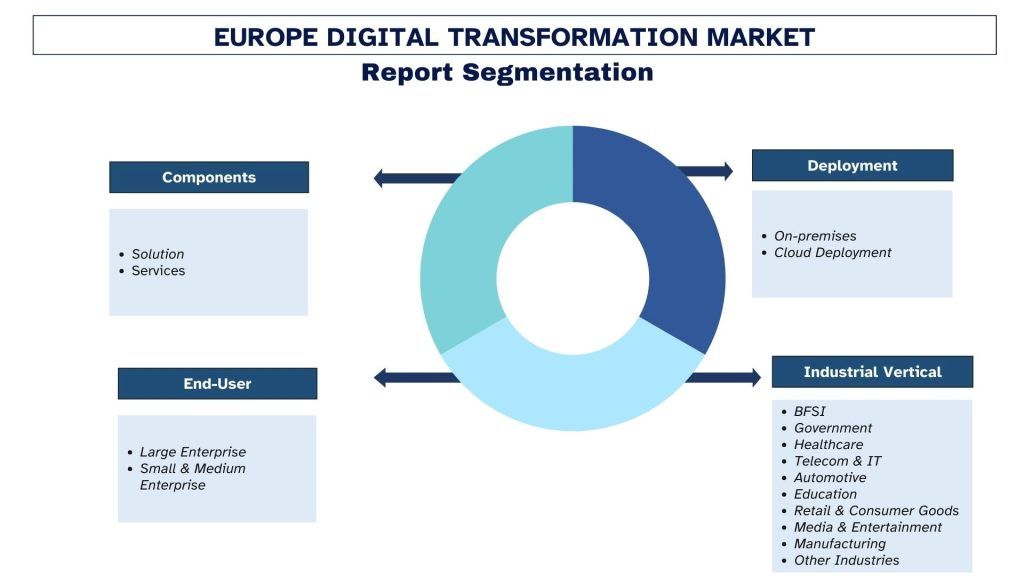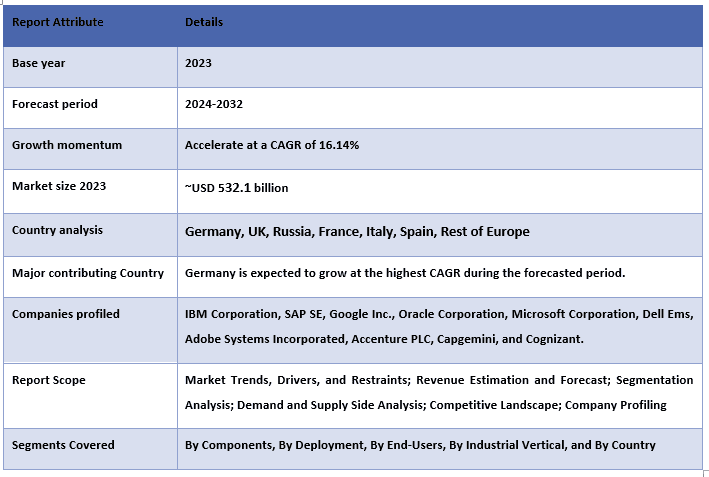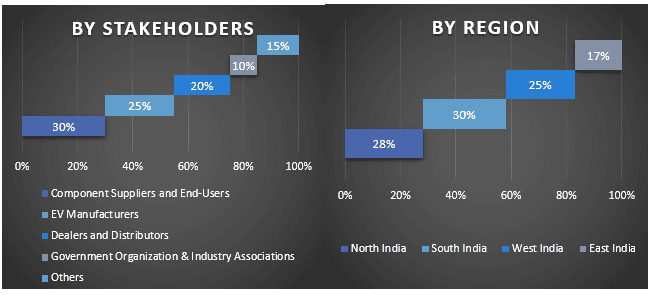- Home
- About Us
- Industry
- Services
- Reading
- Contact Us
Europe Digital Transformation Market: Current Analysis and Forecast (2024-2032)
Emphasis on Component [Solutions (Cloud Computing, Big Data & Analytics, Mobility, Disruptive Technology, Social Media); Services (Professional Services, System Integration)]; by Deployment Type (On-Premises, Cloud); by End-User (Large Enterprises, Small and Medium Enterprises); Industry Verticals (BFSI, Government, Healthcare, Telecom & IT, Automotive, Retail & Consumer Goods, Media & Entertainment, Manufacturing, Other industry) and Country
Europe Digital Transformation Market Size & Forecast
The Europe Digital Transformation market was valued at approximately USD 532.1 Billion in 2023 and is expected to grow at a robust CAGR of around 16.14% during the forecast period (2024-2032) adoption of cloud technologies, AI, and automation, alongside the need for improved operational efficiency and customer experience across industries.
Europe Digital Transformation Market Analysis
Digital transformation is the integration of digital technology in almost all areas of business, fundamentally changing how organizations operate and deliver value to customers. Companies are now being provided with an opportunity to radically change their business models via new digital technologies such as social networks, mobile, big data, the Internet of things, and other innovations like blockchain. This typically includes changes of the core business operations and modifies products and processes, as well as organizational structures, as companies ought to set up management practices to conduct these complex transformations. Organizations today increasingly realize they can no longer focus on just selling products; they need to sell an experience. An increasing number of products today both consume and generate data, and many are interconnected through the Web. Because of this increased intelligence, their usage can be monitored, additional services can be proactively offered, or maintenance can be provided when a problem is detected. Digitalization is the cause of large-scale and sweeping transformations across multiple aspects of business, providing unparalleled opportunities for value creation, while also representing a major source of risk.

Europe Digital Transformation Market Trends
This section discusses the key market trends influencing the Europe Digital Transformation segments as identified by our research experts.
Solution Segment Transforming Industry
Based on the component, the digital transformation market is bifurcated into Solutions and Services. In 2023, Solutions holds the major share of the Europe Digital Transformation Market and is expected to remain dominant throughout the analyzed period. The solution sub-segment is further subdivided into cloud computing, big data and analytics, mobility, disruptive technology, and social media. Moreover, the Service segment is divided into professional services and system integration. Digital transformation helps the organization to compete better in the market by understanding customer preferences and enhancing operational efficiency.
Germany Dominated the Market in 2023
German industry encourages both national and European regulators to develop an environment that enables companies to harness the full potential of digitalization. Adding to this, companies are turning more and more into smart factories with an increasing interconnection between humans, machines, and processes. Products and services as well as overall competitiveness can be enhanced by using digital technologies. For instance: BMW’s plant in Munich, Germany, is increasing the use of artificial intelligence (AI) in applications to integrate into the various production processes combined with smart data analytics for enhanced efficiency in vehicle production. Cisco and Oxbotica, a global autonomous vehicle software company partnered to demonstrate an open roaming platform that can enable the seamless and secure sharing of high-volume data by autonomous fleets while on the move in a cost-effective way.

Europe Digital Transformation Industry Overview
Europe Digital Transformation is competitive, with several Indian and international market players. The key players are adopting different growth strategies to enhance their market presence, such as partnerships, agreements, collaborations, new product launches, geographical expansions, and mergers and acquisitions. Some of the major players operating in the market are IBM Corporation, SAP SE, Google Inc., Oracle Corporation, Microsoft Corporation, Dell Ems, Adobe Systems Incorporated, Accenture PLC, Capgemini, and Cognizant.
Europe Digital Transformation Market Report Coverage

Reasons to buy this report:
- The study includes market sizing and forecasting analysis validated by authenticated key industry experts.
- The report presents a quick review of overall industry performance at one glance.
- The report covers an in-depth analysis of prominent industry peers with a primary focus on key business financials, product portfolios, expansion strategies, and recent developments.
- Detailed examination of drivers, restraints, key trends, and opportunities prevailing in the industry.
- The study comprehensively covers the market across different segments.
- Deep dive regional level analysis of the industry.
Customization Options:
Europe Digital Transformation can further be customized as per the requirement or any other market segment. Besides this, UMI understands that you may have your own business needs; hence, feel free to connect with us to get a report that completely suits your requirements.
Table of Content
Research Methodology for the Europe Digital Transformation Market Analysis (2022-2032)
Analyzing the historical market, estimating the current market, and forecasting the future market of the Europe Digital Transformation market were the three major steps undertaken to create and analyze the adoption of Europe Digital Transformation in major countries. Exhaustive secondary research was conducted to collect the historical market numbers and estimate the current market size. Secondly, numerous findings and assumptions were taken into consideration to validate these insights. Moreover, exhaustive primary interviews were also conducted, with industry experts across the value chain of the Europe Digital Transformation market. Post assumption and validation of market numbers through primary interviews, we employed a top-down/bottom-up approach to forecasting the complete market size. Thereafter, market breakdown and data triangulation methods were adopted to estimate and analyze the market size of segments and sub-segments of the industry. Detailed methodology is explained below:
Analysis of Historical Market Size
Step 1: In-Depth Study of Secondary Sources:
A detailed secondary study was conducted to obtain the historical market size of the Europe Digital Transformation market through company internal sources such as annual reports & financial statements, performance presentations, press releases, etc., and external sources including journals, news & articles, government publications, competitor publications, sector reports, third-party database, and other credible publications.
Step 2: Market Segmentation:
After obtaining the historical market size of Europe Digital Transformation, we conducted a detailed secondary analysis to gather historical market insights and share for different segments & sub-segments for major countries. Major segments are included in the report, such as components, deployment, end-users, industrial vertical, and region. Further country-level analyses were conducted to evaluate the overall adoption of testing models in that region.
Step 3: Factor Analysis:
After acquiring the historical market size of different segments and sub-segments, we conducted a detailed factor analysis to estimate the current market size of the Europe Digital Transformation market. Further, we conducted factor analysis using dependent and independent variables such as components, deployment, end-users, industrial vertical, and Europe Digital Transformation countries. A thorough analysis was conducted of demand and supply-side scenarios considering top partnerships, mergers and acquisitions, business expansion, and product launches in the Europe Digital Transformation market sector across the globe.
Current Market Size Estimate & Forecast
Current Market Sizing: Based on actionable insights from the above three steps, we arrived at the current market size, key players in the Europe Digital Transformation market, and market shares of the segments. All the required percentage shares split, and market breakdowns were determined using the above-mentioned secondary approach and were verified through primary interviews.
Estimation & Forecasting: For market estimation and forecast, weights were assigned to different factors including drivers & trends, restraints, and opportunities available for the stakeholders. After analyzing these factors, relevant forecasting techniques i.e., the top-down/bottom-up approach were applied to arrive at the market forecast for 2032 for different segments and sub-segments across the major markets. The research methodology adopted to estimate the market size encompasses:
The industry’s market size, in terms of revenue (USD) and the adoption rate of the Europe Digital Transformation across the major markets domestically
All percentage shares, splits, and breakdowns of market segments and sub-segments
Key players in the Europe Digital Transformation in terms of products offered. Also, the growth strategies adopted by these players to compete in the fast-growing market
Market Size and Share Validation
Primary Research: In-depth interviews were conducted with the Key Opinion Leaders (KOLs), including Top Level Executives (CXO/VPs, Sales Head, Marketing Head, Operational Head, Regional Head, Country Head, etc.) across major countries. Primary research findings were then summarized, and statistical analysis was performed to prove the stated hypothesis. Inputs from primary research were consolidated with secondary findings, hence turning information into actionable insights.
Split of Primary Participants in Different Countries

Market Engineering
The data triangulation technique was employed to complete the overall market estimation and to arrive at precise statistical numbers for each segment and sub-segment of the Europe Digital Transformation. Data was split into several segments and sub-segments after studying various parameters and trends in the components, deployment, end-users, industrial vertical, and countries of the Europe Digital Transformation market.
The main objective of the Europe Digital Transformation Market Study
The current & future market trends of the Europe Digital Transformation were pinpointed in the study. Investors can gain strategic insights to base their discretion for investments on the qualitative and quantitative analysis performed in the study. Current and future market trends determined the overall attractiveness of the market at a regional level, providing a platform for the industrial participant to exploit the untapped market to benefit from a first-mover advantage. Other quantitative goals of the studies include:
- Analyze the current and forecast market size of the Europe Digital Transformation market in terms of value (USD). Also, analyze the current and forecast market size of different segments and sub-segments.
- Segments in the study include areas of components, deployment, end-users, industrial vertical, and countries.
- Define and analyze the regulatory framework for the Europe Digital Transformation
- Analyze the value chain involved with the presence of various intermediaries, along with analyzing customer and competitor behaviors of the industry.
- Analyze the current and forecast market size of the Europe Digital Transformation market for the major countries.
- Major countries studied in the report include Germany, UK, Russia, France, Italy, Spain, Rest of Europe
- Company profiles of the European digital Transformation market and the growth strategies adopted by the market players to sustain in the fast-growing market.
- Deep dive regional level analysis of the industry
Frequently Asked Questions FAQs
Q1: What is Europe Digital Transformation current size and growth potential?
Q2: What are the driving factors for the growth of Europe Digital Transformation Market?
Q3: Which segment has the largest share of the Europe Digital Transformation by components?
Q4: What are the emerging technologies and trends in Europe Digital Transformation Market?
Q5: Which region will dominate the Europe Digital Transformation Market?
Related Reports
Customers who bought this item also bought











